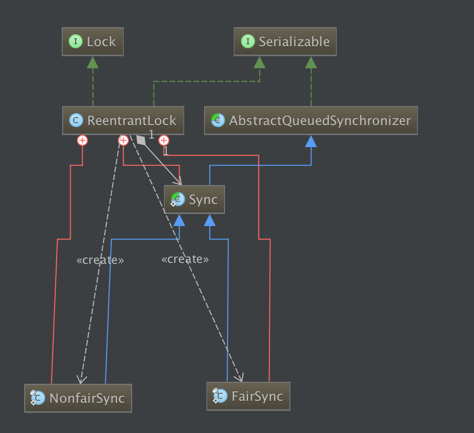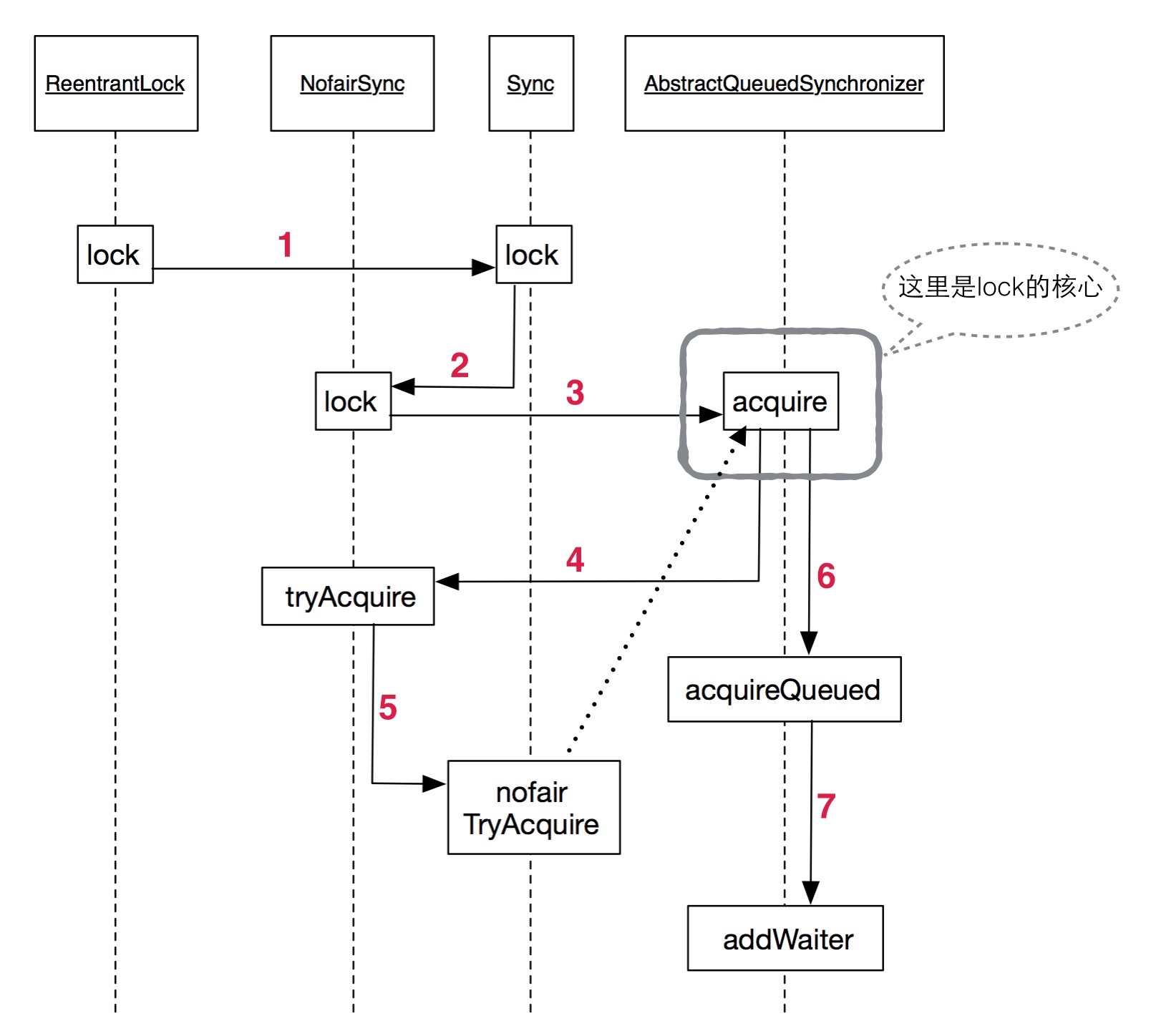Lock的实现之ReentrantLock详解
摘要
Lock在硬件层面依赖CPU指令,完全由Java代码完成,底层利用LockSupport类和Unsafe类进行操作;
虽然锁有很多实现,但是都依赖AbstractQueuedSynchronizer类,我们用ReentrantLock进行讲解;
ReentrantLock调用过程
ReentrantLock类的API调用都委托给一个内部类 Sync ,而该类继承了 AbstractQueuedSynchronizer类;
public class ReentrantLock implements Lock, java.io.Serializable {
......
abstract static class Sync extends AbstractQueuedSynchronizer {
......
而Sync又分为两个子类:公平锁和非公平锁,默认为非公平锁
/** * Sync object for non-fair locks */ static final class NonfairSync extends Sync {
/** * Sync object for fair locks */ static final class FairSync extends Sync {
Lock的调用过程如下图(其中涉及到 ReentrantLock类、Sync(抽象类)、AbstractQueuedSynchronizer类,NofairSync类,这些类将 Template方法用的淋漓尽致,相当赞):
先来一张类依赖图:

再来一张lock调用图:

Lock API详解
自底而上来看,由被调用一步步向上分析
nofairTryAcquire
/**
* Performs non-fair tryLock. tryAcquire is implemented in
* subclasses, but both need nonfair try for trylock method.
*/
final boolean nonfairTryAcquire(int acquires) {
final Thread current = Thread.currentThread();
int c = getState();
if (c == 0) {
if (compareAndSetState(0, acquires)) {
setExclusiveOwnerThread(current);
return true;
}
}
else if (current == getExclusiveOwnerThread()) {
int nextc = c + acquires;
if (nextc < 0) // overflow
throw new Error("Maximum lock count exceeded");
setState(nextc);
return true;
}
return false;
}
来看这段代码,首先获取当前状态(初始化为0),当它等于0的时候,代表还没有任何线程获得该锁,然后通过CAS(底层是通过CompareAndSwapInt实现)改变state,并且设置当前线程为持有锁的线程;其他线程会直接返回false;当该线程重入的时候,state已经不等于0,这个时候并不需要CAS,因为该线程已经持有锁,然后会重新通过setState设置state的值,这里就实现了一个偏向锁的功能,即锁偏向该线程;
addWaiter
只有当锁被一个线程持有,另外一个线程请求获得该锁的时候才会进入这个方法
/**
* Creates and enqueues node for current thread and given mode.
*
* @param mode Node.EXCLUSIVE for exclusive, Node.SHARED for shared
* @return the new node
*/
private Node addWaiter(Node mode) {
Node node = new Node(Thread.currentThread(), mode);
// Try the fast path of enq; backup to full enq on failure
Node pred = tail;
if (pred != null) {
node.prev = pred;
if (compareAndSetTail(pred, node)) {
pred.next = node;
return node;
}
}
enq(node);
return node;
}
首先持有该锁之外的线程进入到该方法,这里涉及到一个CLH(三个人的名字首字母:Craig, Landin, and Hagersten)队列,其实就是一个链表,
简单说下CLH队列:
CLH队列由node节点组成,mode代表每个Node有两种模式:共享模式和排他模式,并且维护了一个状态:waitStatus,可取值如下:
- CANCELLED = 1 由于超时或者被打断,该线程被取消,将不会被block;
- SIGNAL = -1 当前线程的后继节点线程通过park正处于或即将处于block状态;
- CONDITION = -2 当前线程正处于条件队列,正式因为调用了condition.await造成阻塞;
- PROPAGATE = -3 共享锁应该被传播出去
首先,new一个节点,这个时候模式为:mode为 Node.EXCLUSIVE,默认为null即排它锁;
然后:
如果该队列已经有node即tail!=null,则将新节点的前驱节点置为tail,再通过CAS将tail指向当前节点,前驱节点的后继节点指向当前节点,然后返回当前节点;
如果队列为空或者CAS失败,则通过enq入队:
/**
* Inserts node into queue, initializing if necessary. See picture above.
* @param node the node to insert
* @return node's predecessor
*/
private Node enq(final Node node) {
for (;;) {
Node t = tail;
if (t == null) { // Must initialize
if (compareAndSetHead(new Node()))
tail = head;
} else {
node.prev = t;
if (compareAndSetTail(t, node)) {
t.next = node;
return t;
}
}
}
}
进队的时候,要么是第一个入队并且设置head节点并且循环设置tail,要么是add tail,如果CAS不成功,则会无限循环,直到设置成功,即使高并发的场景,也最终能够保证设置成功,然后返回包装好的node节点;
acquireQueued
/**
* Acquires in exclusive uninterruptible mode for thread already in
* queue. Used by condition wait methods as well as acquire.
*
* @param node the node
* @param arg the acquire argument
* @return {@code true} if interrupted while waiting
*/
final boolean acquireQueued(final Node node, int arg) {
boolean failed = true;
try {
boolean interrupted = false;
for (;;) {
final Node p = node.predecessor();
if (p == head && tryAcquire(arg)) {
setHead(node);
p.next = null; // help GC
failed = false;
return interrupted;
}
if (shouldParkAfterFailedAcquire(p, node) &&
parkAndCheckInterrupt())
interrupted = true;
}
} finally {
if (failed)
cancelAcquire(node);
}
}
该方法的主要作用就是将已经进入虚拟队列的节点进行阻塞,我们看到,如果当前节点的前驱节点是head并且尝试获取锁的时候成功了,则直接返回,不需要阻塞;
如果前驱节点不是头节点或者获取锁的时候失败了,则进行判定是否需要阻塞:
/**
* Checks and updates status for a node that failed to acquire.
* Returns true if thread should block. This is the main signal
* control in all acquire loops. Requires that pred == node.prev.
*
* @param pred node's predecessor holding status
* @param node the node
* @return {@code true} if thread should block
*/
private static boolean shouldParkAfterFailedAcquire(Node pred, Node node) {
int ws = pred.waitStatus;
if (ws == Node.SIGNAL)
/*
* This node has already set status asking a release
* to signal it, so it can safely park.
*/
return true;
if (ws > 0) {
/*
* Predecessor was cancelled. Skip over predecessors and
* indicate retry.
*/
do {
node.prev = pred = pred.prev;
} while (pred.waitStatus > 0);
pred.next = node;
} else {
/*
* waitStatus must be 0 or PROPAGATE. Indicate that we
* need a signal, but don't park yet. Caller will need to
* retry to make sure it cannot acquire before parking.
*/
compareAndSetWaitStatus(pred, ws, Node.SIGNAL);
}
return false;
}
这段代码对该节点的前驱节点的状态进行判断,如果前驱节点已经处于signal状态,则返回true,表明当前节点可以进入阻塞状态;
否则,将前驱节点状态CAS置为signal状态,然后通过上层的for循环进入parkAndCheckInterrupt代码块park:
/**
* Convenience method to park and then check if interrupted
*
* @return {@code true} if interrupted
*/
private final boolean parkAndCheckInterrupt() {
LockSupport.park(this);
return Thread.interrupted();
}
这个时候将该线程交给操作系统内核进行阻塞;
总体来讲,acquireQueued就是依靠前驱节点的状态来决定当前线程是否应该处于阻塞状态,如果前驱节点处于cancel状态,则丢弃这些节点,重新构建队列;
Unlock API详解
流程类似lock api相关类的流程,这里讲主要的代码,unlock相对的比较简单
首先 ReentrantLock 调用 Sync的release接口也就是AbstractQueuedSynchronizer的release接口
/**
* Releases in exclusive mode. Implemented by unblocking one or
* more threads if {@link #tryRelease} returns true.
* This method can be used to implement method {@link Lock#unlock}.
*
* @param arg the release argument. This value is conveyed to
* {@link #tryRelease} but is otherwise uninterpreted and
* can represent anything you like.
* @return the value returned from {@link #tryRelease}
*/
public final boolean release(int arg) {
if (tryRelease(arg)) {
Node h = head;
if (h != null && h.waitStatus != 0)
unparkSuccessor(h);
return true;
}
return false;
}
这个时候会先调用Sync的tryRelease,如果返回true,则释放锁成功
protected final boolean tryRelease(int releases) {
int c = getState() - releases;
if (Thread.currentThread() != getExclusiveOwnerThread())
throw new IllegalMonitorStateException();
boolean free = false;
if (c == 0) {
free = true;
setExclusiveOwnerThread(null);
}
setState(c);
return free;
}
这个接口的作用很简单,如果不是获得锁的线程调用直接抛出异常,否则,如果当前state-releases==0也就是lock已经完全释放,返回true,清除资源;
这个返回free之后,release拿到head节点,进入以下代码:
/**
* Wakes up node's successor, if one exists.
*
* @param node the node
*/
private void unparkSuccessor(Node node) {
/*
* If status is negative (i.e., possibly needing signal) try
* to clear in anticipation of signalling. It is OK if this
* fails or if status is changed by waiting thread.
*/
int ws = node.waitStatus;
if (ws < 0)
compareAndSetWaitStatus(node, ws, 0); /*
* Thread to unpark is held in successor, which is normally
* just the next node. But if cancelled or apparently null,
* traverse backwards from tail to find the actual
* non-cancelled successor.
*/
Node s = node.next;
if (s == null || s.waitStatus > 0) {
s = null;
for (Node t = tail; t != null && t != node; t = t.prev)
if (t.waitStatus <= 0)
s = t;
}
if (s != null)
LockSupport.unpark(s.thread);
}
这个作用即:当头结点的状态小于0,则将头结点的状态CAS为0,然后通过链表获取下一个节点,如果下一个节点为null或者不符合要求的状态,则从队尾遍历整个链表,直到遍历到离head节点最近的一个节点并且
等待状态符合预期,则将头结点的后继节点置为该节点;
对刚刚筛出来的符合要求的节点唤醒,也就是该节点获得 争夺 锁的权利;
这就是非公平锁的特点:在队列一直等待的线程不一定比后来的线程先获得锁,至此,unlock 已经解释完成;
Lock的实现之ReentrantLock详解的更多相关文章
- java之ReentrantLock详解
前言 如果一个代码块被synchronized修饰了,当一个线程获取了相应的锁,并执行该代码块时,其他线程便只能一直等待,等待获取锁的释放,现在有这么一种情况,这个获取锁的线程由于要等待IO或者其他原 ...
- ReentrantLock详解 以及与synchronized的区别
ReentrantLock lock = new ReentrantLock(); //参数默认false,不公平锁 ReentrantLock lock = new ReentrantLock(tr ...
- 图解AQS原理之ReentrantLock详解-非公平锁
概述 并发编程中,ReentrantLock的使用是比较多的,包括之前讲的LinkedBlockingQueue和ArrayBlockQueue的内部都是使用的ReentrantLock,谈到它又不能 ...
- ReentrantLock 详解
ReentrantLock的功能是实现代码段的并发访问控制,也就是通常意义上所说的锁,java中实现锁有两种方式,一种是本文所提的ReentrantLock,另一种是synchronized.Reen ...
- Java并发之ReentrantLock详解
一.入题 ReentrantLock是Java并发包中互斥锁,它有公平锁和非公平锁两种实现方式,以lock()为例,其使用方式为: ReentrantLock takeLock = new Reent ...
- ReentrantLock详解
ReentrantLock概述 ReentrantLock是Lock接口的实现类,可以手动的对某一段进行加锁.ReentrantLock可重入锁,具有可重入性,并且支持可中断锁.其内部对锁的控制有两种 ...
- Java并发编程(06):Lock机制下API用法详解
本文源码:GitHub·点这里 || GitEE·点这里 一.Lock体系结构 1.基础接口简介 Lock加锁相关结构中涉及两个使用广泛的基础API:ReentrantLock类和Condition接 ...
- 从ReentrantLock详解AQS原理源码解析
数据结构 java.util.concurrent.locks.AbstractQueuedSynchronizer类中存在如下数据结构. // 链表结点 static final class Nod ...
- 最强Java并发编程详解:知识点梳理,BAT面试题等
本文原创更多内容可以参考: Java 全栈知识体系.如需转载请说明原处. 知识体系系统性梳理 Java 并发之基础 A. Java进阶 - Java 并发之基础:首先全局的了解并发的知识体系,同时了解 ...
随机推荐
- Atitit j2ee5 jee5 j2ee6 j2ee7 jee6 jee7 新特性
Atitit j2ee5 jee5 j2ee6 j2ee7 jee6 jee7 新特性 Keyword Java ee5 ,Java ee6,Java ee7 j2ee5 jee5 j2ee6 j2 ...
- fir.im Weekly - 技术人也要苦练“七十二变”
一年又一年,Code,Build,Run.多少技术人像"孙悟空"一样,日复一日苦练"七十二变",笑对"八十一难",最后能"取经成功 ...
- asp.net/html清理页面缓存的方法
(1) MVC BaseController: Controller内 protected override void Initialize(System.Web.Routing.RequestC ...
- KnockoutJS 3.X API 第四章 表单绑定(10) textInput、hasFocus、checked绑定
textInput绑定目的 textInput绑定主要用于<input>或者<textarea>元素.他提供了DOM和viewmodel的双向更新.不同于value绑定,tex ...
- KendoUI系列:DropDownList
1.基本使用 1>.创建Input <input id="dropDownList" /> <link href="@Url.Content(&q ...
- 队列-java代码
public class QueueDemo { private int maxSize; private long[] queueArray; // 队列的头,实际是数组的尾 private int ...
- C#中使用Oracle存储过程返回结果集
问题: 在MSSQLServer中定义的存储过程可以直接返回一个数据集,如: create procedure sp_getAllEmployees as SELECT * FROM [NORTHWN ...
- LSA,pLSA原理及其代码实现
一. LSA 1. LSA原理 LSA(latent semantic analysis)潜在语义分析,也被称为 LSI(latent semantic index),是 Scott Deerwest ...
- 学习使用 CSS3 制作网站面包屑导航效果
作为最重要的导航展示形式之一,面包屑导航能够让用户更清楚的知道他们所在页面的层次结构,让他们可以方便的导航到上一层页面.在本教程中,您将学习如何使用 CSS3 技术创建自己的面包屑导航效果. 效果演示 ...
- MAC Objective-C 开发经典书籍推荐
MAC Objective-C 开发经典书籍推荐 闻道有先后,术业有专攻,这句话放到计算机科学领域的理解可能每个人都会不同. 有些人选择一个操作系统,一个体系的编程语言,作一个领域的开发. 有些人选择 ...
